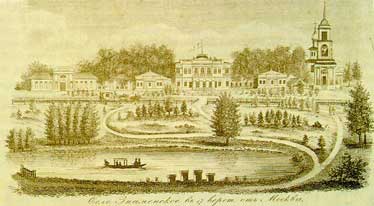- Location
- North pole of the world
- polar Star
- Asterism
- Meteor showers
- Constellation history
- How to find the Little Dipper - choose the right situation
- How to find the Little Dipper by the Polar Star
- How to find the Little Dipper - an additional landmark
Perhaps the most famous constellation in the sky of the northern hemisphere of the Earth. Seven of its brightest stars make up asterism the Big Dipper, which is visible in mid-latitudes all year round. This makes it an indispensable tool for finding constellations in the sky and for orientation on Earth.
Probably, many have heard about the constellation, which is not far from the Big one and is also visible on our sky all year round. Its bright stars form the Asterism Small Dipper, but finding it, as well as the very constellation Ursa Minor, is far from all. Meanwhile, this constellation plays an important role for the inhabitants of the northern hemisphere of the Earth, since it is in it that the famous Polar Star is located, indicating the direction to the north.
Below we briefly describe how to find the Little Dipper by the Big Dipper. Starting from the stars of the Big Dipper, it is not at all difficult to do.
The first thing you need to do is find the sky Big Dipper or rather, (the Big Bear constellation is much larger than the dipper). The easiest thing is to find the Big Dipper in the spring, when in the evenings it is almost at its zenith. In summer, the Big Dipper is located to the west, with the bucket tilted slightly down.
The position of the Big Dipper in the middle of summer. Figure: Stellarium
In autumn, in the north, low above the horizon in an almost horizontal position ...
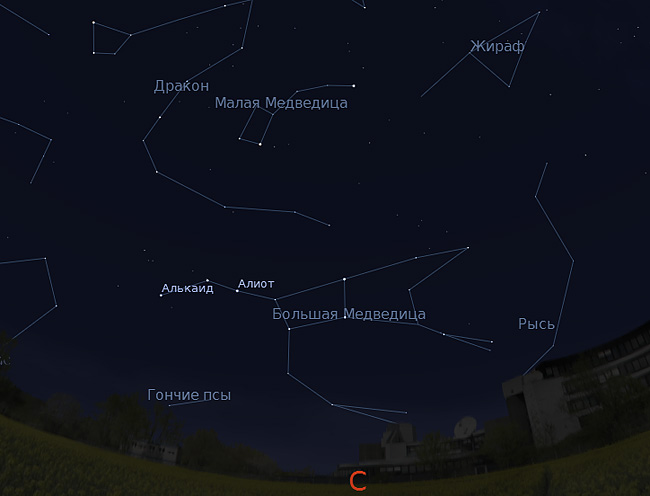
Big Bucket in the fall. Figure: Stellarium
... and in the winter - in the east, while the bucket is almost on the handle.
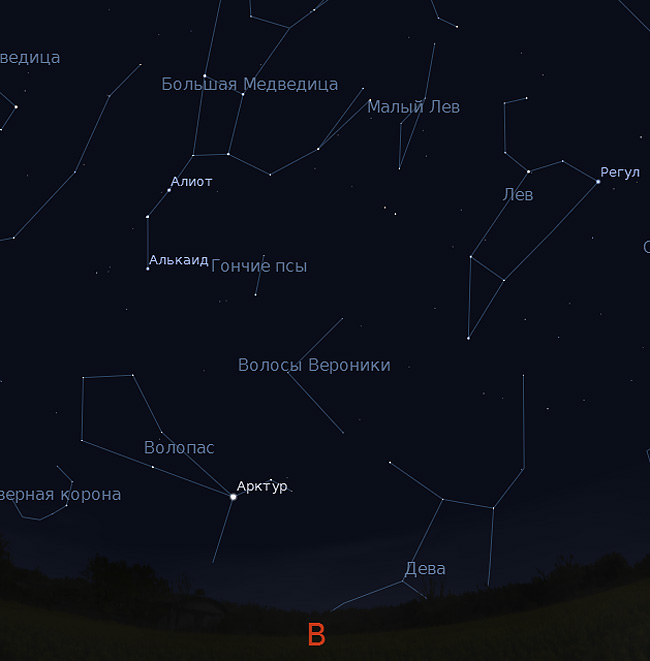
In winter, the Big Dipper is located in the east. Figure: Stellarium
Now that you have found the Big Dipper, mentally connect the two extreme stars that form the wall of the dipper, Merak and Dubhe. Then extend the line further five times the distance of Merak - Dubhe . It will indicate a star of the same brightness as the bucket stars. It is the brightest star of the Ursa Minor constellation.
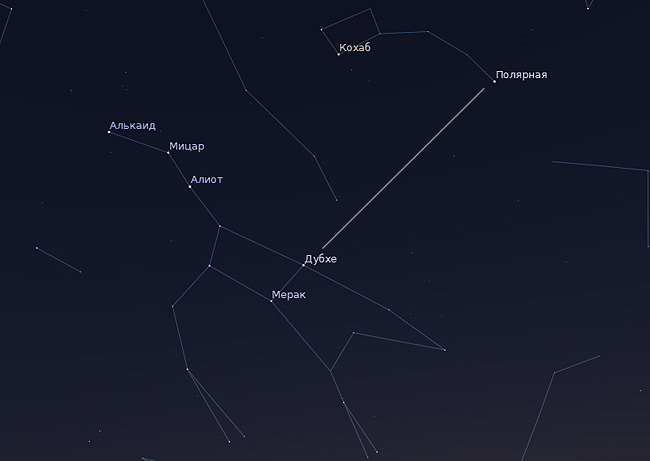
How to find the Little Dipper on the Big Spring. Line Merak - Dubhe points to the Polar Star. Two other bright stars of Ursa Minor, Kokhab and Furkad, are located above the handle of the Big Dipper. Figure: Stellarium
The polestar is located at the tip of the handle of the Small Bucket. The stars that make up the Little Dipper, on the whole, are much dimmer than the stars of the Large Dipper, so finding the Little Dipper in the city in the lighted sky is not easy. The Small Bucket is about half the size of the Big Bucket, and its handle is bent to the other side. Of the seven stars that make up this asterism, only three are reliably visible in the city: the Pole Star in the pen, as well as the Kokhab and Fercad stars that make up the wall of the Little Dipper. The last two stars are above the handle of the Big Dipper Bucket .
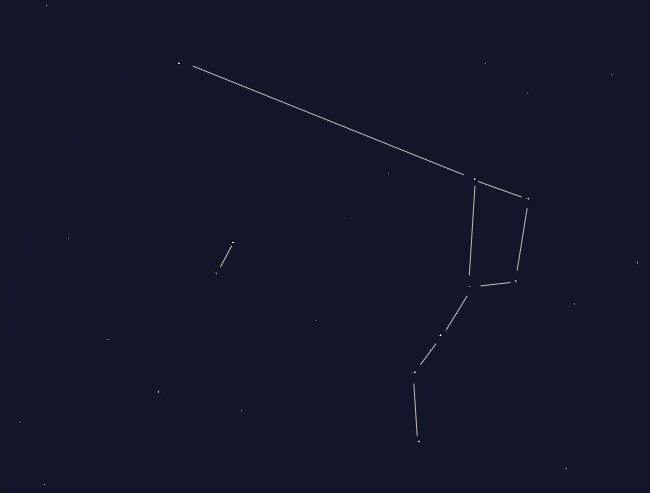
In the city, of the entire constellation Ursa Minor, only the Polar Star is clearly visible, as well as the stars of the walls of the Little Dipper, Kokhab and Farkad. The last two are above the handle of the Big Dipper's bucket and are connected with a dash in the picture for clarity. This position of the Big Dipper relative to the Little Bear can be observed in the spring, when the Big Dipper is almost at its zenith. Figure: Stellarium
To see the Little Bucket as a whole, and not just its extreme stars, you will most likely have to get out of the city, away from the city lights. The night should be dark and, preferably, moonless. Then you find the Bucket relatively easy. The good news is that the Little Dipper, unlike other stellar drawings, does not fundamentally change its position in the sky . If the majority of constellations are seasonal - they are visible only at a certain time of the year, or they drastically change their position in the sky depending on the season, such as, for example, Ursa Major, then the Ursa Minor is always visible in one sector of the sky . The Small Bucket, however, also changes its position, looks now north, now south, now west, now east, but its brightest star, Polar, is always in one place - at any time of the day and at any time of the year. ! The polar star is like an axis around which the Little Dipper moves, as well as all the other constellations.
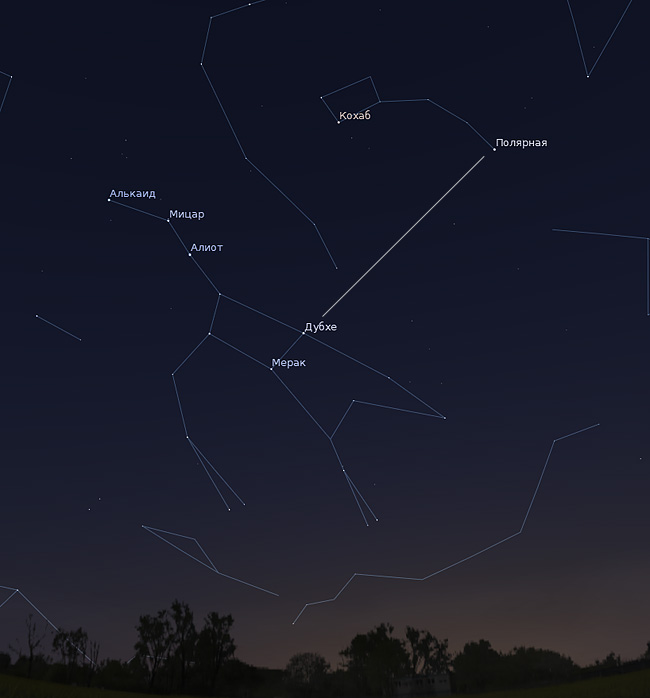
Although the position of the Big Dipper varies from season to season, the position of the Polar Star remains unchanged. The way to search for the Polar by the extreme stars of the Big Dipper bucket works at any time of the year. Figure: Stellarium
This is possible due to the fact that the North Star is near. The unique property of the Polar Star to remain in one place makes it possible to use it as a guide to the terrain. In fact, if you take a perpendicular from the Polar Star to the horizon, it will point exactly north. However, not only the Polar Star, but also the Big Dipper allows for good orientation in the terrain. In the spring, the Big Bucket handle looks east, and the bucket itself faces west, and in the rest of the seasons, as we wrote above, in the evenings the Big Bucket is located either in the west or in the north or in the east, helping to determine the directions of the world.
Learn to find the Little Dipper, Cassiopeia and the Dragon
Prepared by O. Malakhov
So, let's begin our acquaintance with starry sky . Today we will meet the four constellations of the Northern sky: Ursa Major, Ursa Minor (with the famous Polar Star), the Dragon and Cassiopeia. Due to their proximity to the North Pole of the world on the European territory of the former USSR, all these constellations are indispensable. Those. They can be found in the starry sky any day and at any time. The first steps should start with the Big Dipper, known to everyone. Did you find it in the sky? If not, then to search for it, remember that in the summer evenings the “scoop” is in the north-west, in the fall - in the north, in the winter - in the northeast, in the spring - directly overhead. Now pay attention to the two extreme stars of this “bucket” (see fig.).
If you mentally draw a straight line through these two stars, then the very first stellar star, whose brightness is comparable to the brightness of the stars of the “dipper” of Ursa Major, will be the Polar Star, belonging to the constellation Ursa Minor. Using the map shown in the figure, try to find the other stars of this constellation. If you observe in urban settings, then it will be difficult to see the stars of the “small bucket” (namely, the Ursa Minor Bear constellation is informally called): they are not as bright as the stars of the “big bucket”, i.e. Ursa Major. For this it is better to have on hand binoculars. When you make out the constellation Ursa Minor, you can try to find the constellation Cassiopeia. I don’t know about you, but for me it was originally associated with another “bucket”. Rather, it is even a "coffee pot". So, look at the second from the end star of the Big Dipper handles. This is the star, next to which is visible bare star visible to the naked eye. The bright star bears the name of Mizar, and the one next to it is Alcor (here is the model range of the iconic Soviet telescopes for astronomy enthusiasts produced by the Novosibirsk Instrument-Making Plant (Refinery)). They say that if translated from Arabic, then Mizar is a horse, and Alcor is a horseman. Being familiar with the Arabic language, I can’t confirm it, but we trust the books.
So, Mizar found. Now draw a mental line from Mizara through the Polar Star and further approximately the same distance. And you will surely see a rather bright constellation in the form of the Latin letter W (see figure). This is Cassiopeia. Still something like a "coffee pot", is not it?
After Cassiopaea try to find the constellation of the Dragon. As can be seen from the figure at the top of the page, it seems to extend between the “buckets” of the Big and Little Bear, moving further in the direction of Cepheus, Lyra, Hercules and Cygnus. We will talk about these constellations a little later, and, having obtained a basic experience of orientation in the starry sky, try using the above-mentioned figure to find the Dragon constellation completely.
Now you can easily be able to find in the sky the constellations Ursa Major and Ursa Minor, Cassiopeia, Dragon.
Questions:
1. In which area of the sky was the constellation of Cassiopeia during your observations?
2. In what area of the sky was the “dipper” of Ursa Major?
3. Could you see Alcor with the naked eye?
There are constellations in the sky, about the presence of which almost everyone knows. Among them is the constellation Ursa Minor.
The constellation Ursa Minor is located in the subpolar region of the sky and contains 25 stars. But for most people, only seven of them are known, forming asterism, called the Little Dipper. The most popular star of the constellation is the location of which practically coincides with the North Pole of the world. In addition to bright enough stars, the constellation contains in its composition a small elliptical galaxy, nicknamed for its size as the Dwarf Ursa Minor.
Location
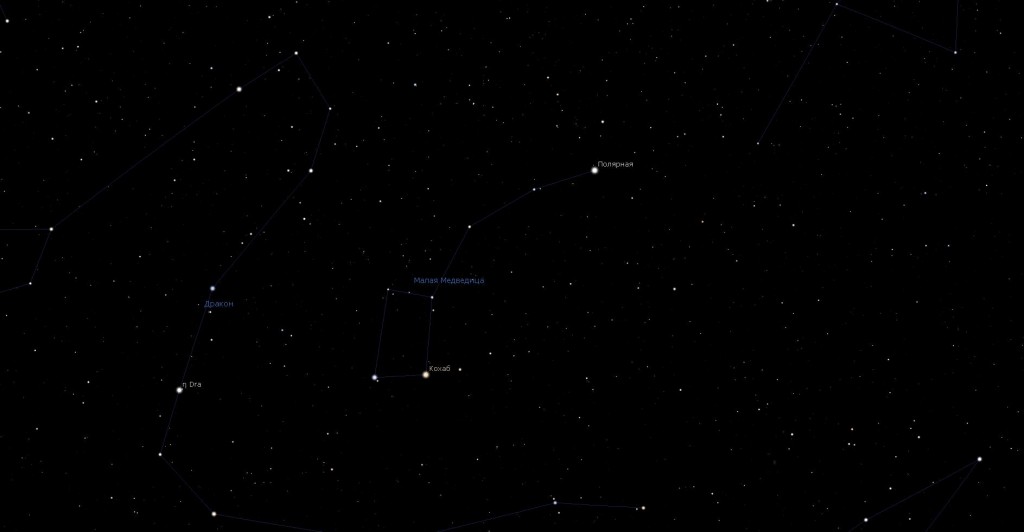
The constellation Ursa Minor, view in the program of the planetarium Stellarium
To find a constellation in the sky is quite simple. His neighbors are Giraffe, Dragon and Cepheus. But the guide for the search usually serves. Having looked through the line through the two extreme luminaries of its bucket, and measuring up five distances between them, you can find the Polar Star, which serves as the beginning of the “handle” of another, smaller “scoop”. This will be Ursa Minor. It is less bright than the Big one, but it is still clearly expressed in the sky and is easily distinguishable from other constellations. In the Northern Hemisphere, this constellation is available for observation year-round.
North pole of the world
The pole is the point of the celestial sphere, which to the observer on the Earth seems to be stationary, while all other objects rotate around it. If there is a bright star nearby, then it can serve as a guide, since its location does not depend on the time of day. Due to the peculiarities of the Earth’s movement, this point is moving, but on the scale of centuries it can be considered unchanged. Currently, the pole star is closest to the pole. She is only 40 angular minutes away from him in angular terms.
polar Star
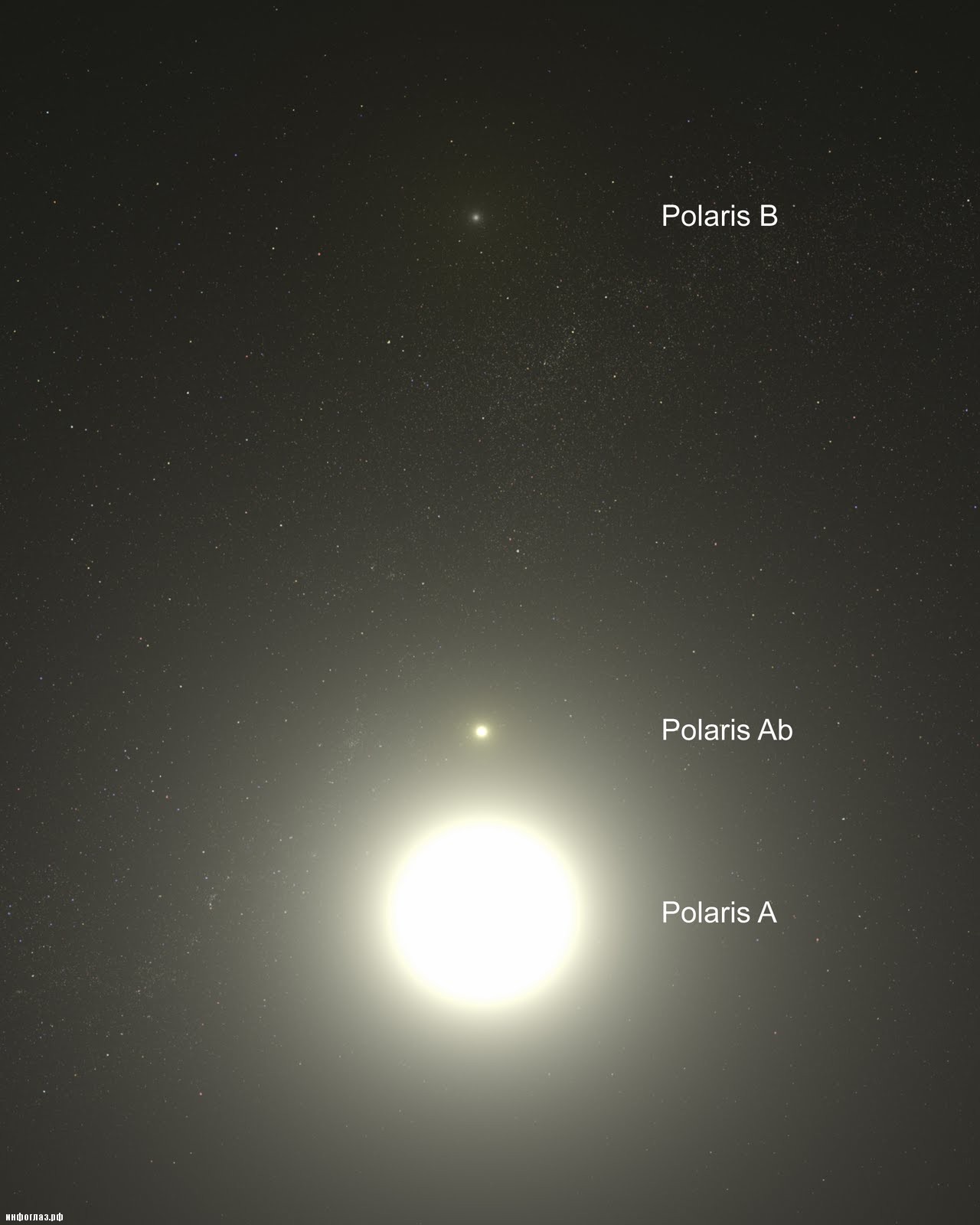
The Alpha Ursa Minor is located 434 light years away from Earth and has an apparent magnitude of 1.97. But in fact, this is not one luminary, but three, united in a system. The largest of them is 4.5 times more massive than the Sun and two thousand times brighter than it. The second largest star is at a fairly decent distance from the main one; it can even be viewed with a small telescope. Mass of light - about 1.39 solar. The third star is so close to the first one that they could only visually be separated with the help of the telescope, and even that was done with great difficulty. It is heavier than the sun by 1.25 times.
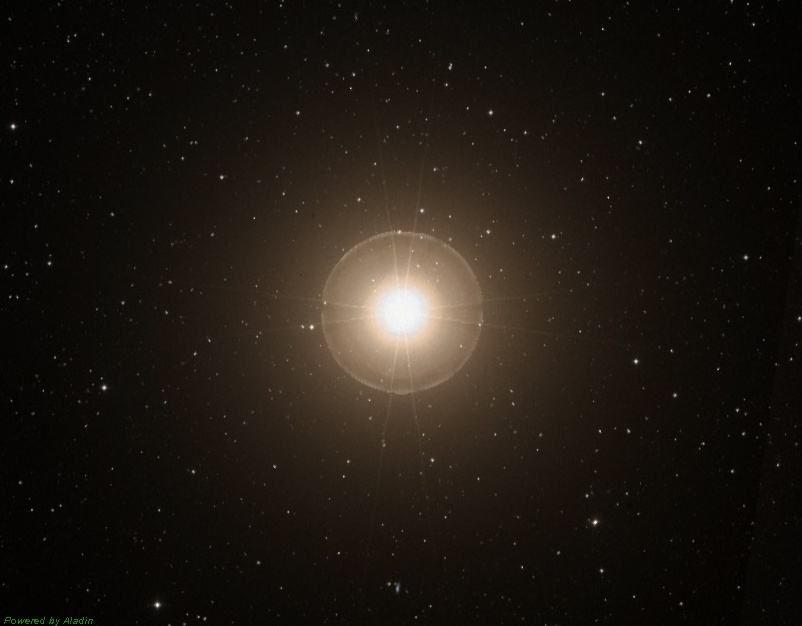
The second luminosity of the Little Bear is its beta, which has an apparent magnitude of 2.08. The star is about 126 light-years away from Earth. Its name, translated from Arabic, means “Star of the North”, since a certain period of time BC (estimated from 2000 to 500) Kokhab of the closest luminaries was located to the pole and served as the navigation reference point for the peoples living at that time. Korean astronomers discovered a planet in 2014 with this binary star, the mass of which is 6.1 times more than Jupiter’s. The circulation period of this gas giant is 522.3 days.
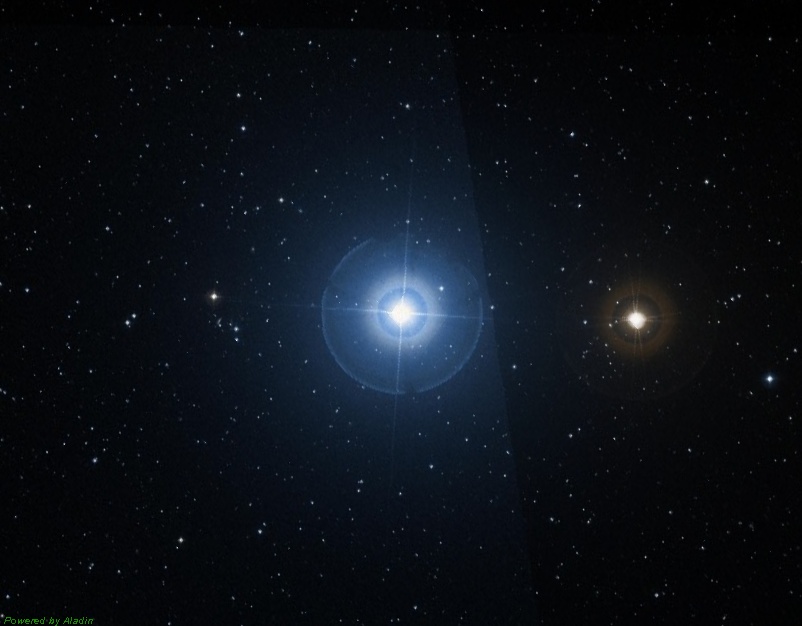
The Ursa Minor Gamma is about 480 light-years distant from Earth and has an apparent magnitude varying from 3.04 to 3.09. The period of change of brightness of the star is 3.43 hours. This third brightest object of the constellation is a hot giant with a temperature of about 8,600 K. Its luminosity is 1.1 thousand times greater than the sun's, and in size it is 15 times larger than our yellow dwarf. According to the classification applies to variable luminaries of type T Shield.
Asterism
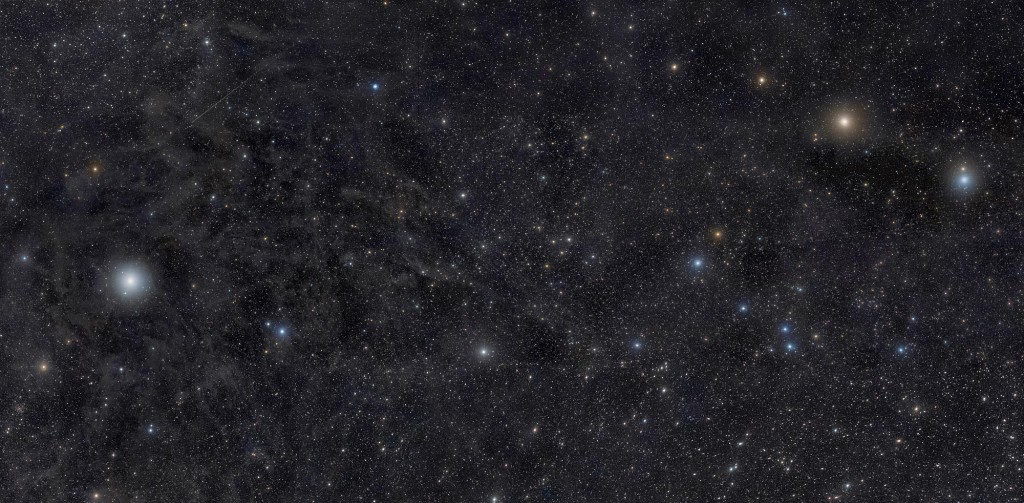
The constellation contains two asterisms: the Little Dipper and the Guardians of the Pole. The first is well known to modern observers. It is very similar to the Big Dipper, located nearby, but only less bright. It is formed by the most visible luminaries of the heavenly formation. Quite a few believe that Ursa Minor is limited to these seven objects, although in fact there are 18 more stars in its composition.
The second asterism is much less known and goes by its name in ancient times when its two luminaries, called Ferkad and Kokhab, were located closer to the pole than the Polar Star.
Meteor showers
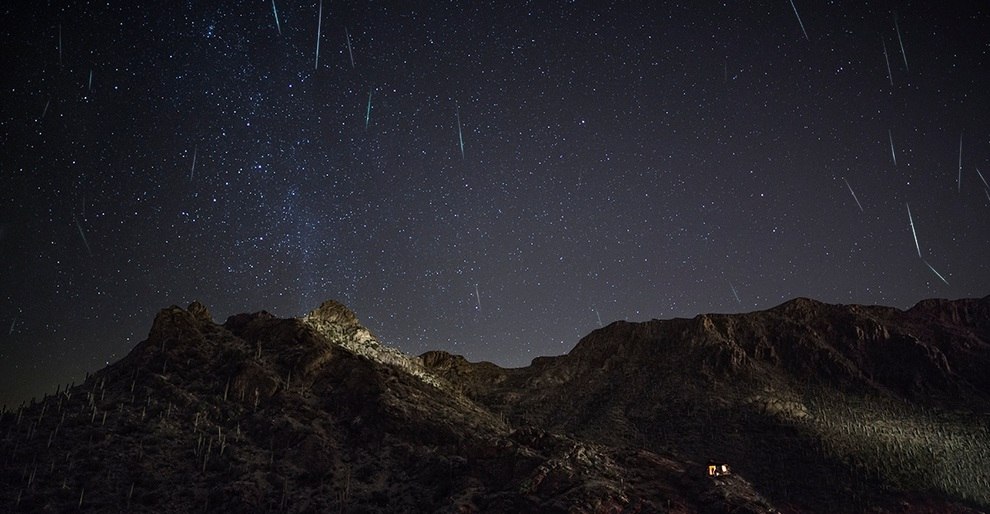
Ursa Minor serves as a radiant, the last "stargazing" of the year, which is studied rather poorly. Its radiant lies near the Little Bucket, the meteor rain comes from December 17 to 25, and is extremely unpredictable. Usually in the most active days in it for an hour you can see from 10 to 20 meteors, which is of little interest to an ordinary observer. But there are unpredictable bursts of activity when their number exceeds a hundred. 1988, 1994, 2000, 2006 and especially 1945 and 1986 were such "fruitful" for meteors. It is the northernmost of these streams - it is due to its birth to the short-period comet Tuttle.
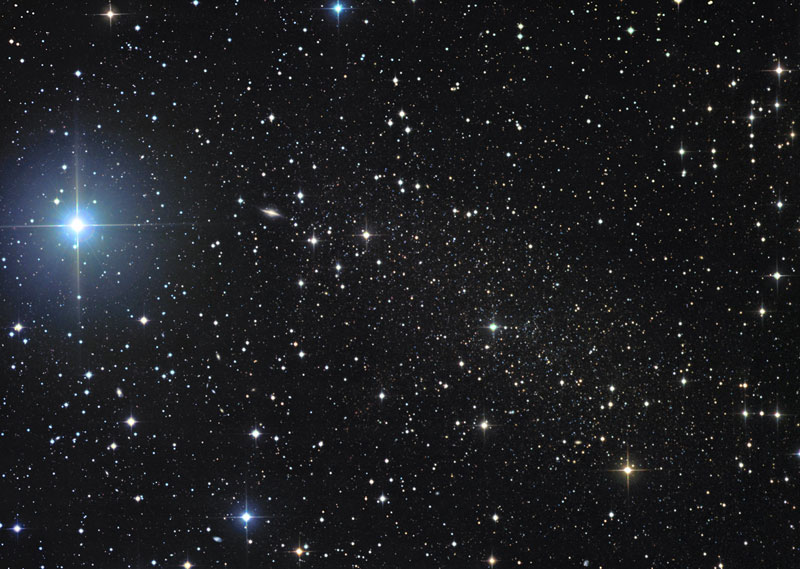
In addition to the main stars, in the Little Bear galaxies located in it are of interest. The already mentioned Dwarf, which is a satellite of the Milky Way, was discovered in 1954. This is a rather old galaxy, which is at least ten billion years old. It is too small to see if it contains gas, dust and any star formation processes. Sometimes due to a location close to the axis of rotation of the Earth, it is called Polarissim.
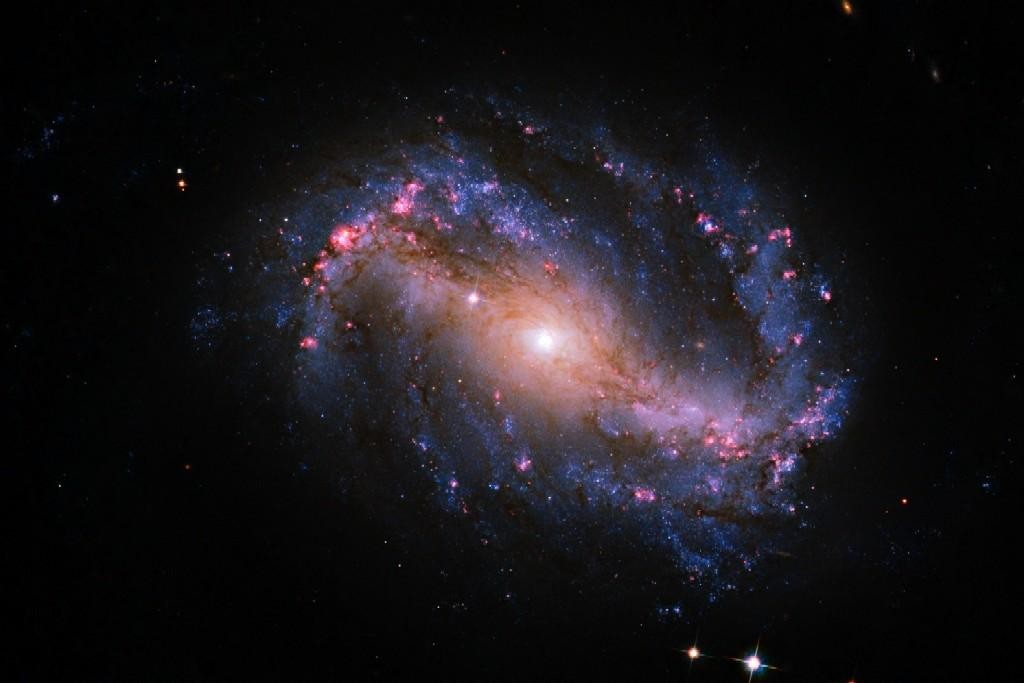
In addition, there are galaxies NGC 6217 and NGC 5832 in the constellation. All of the objects listed on a space scale are very small, and therefore it is impossible to observe them without good optical equipment.
Constellation history
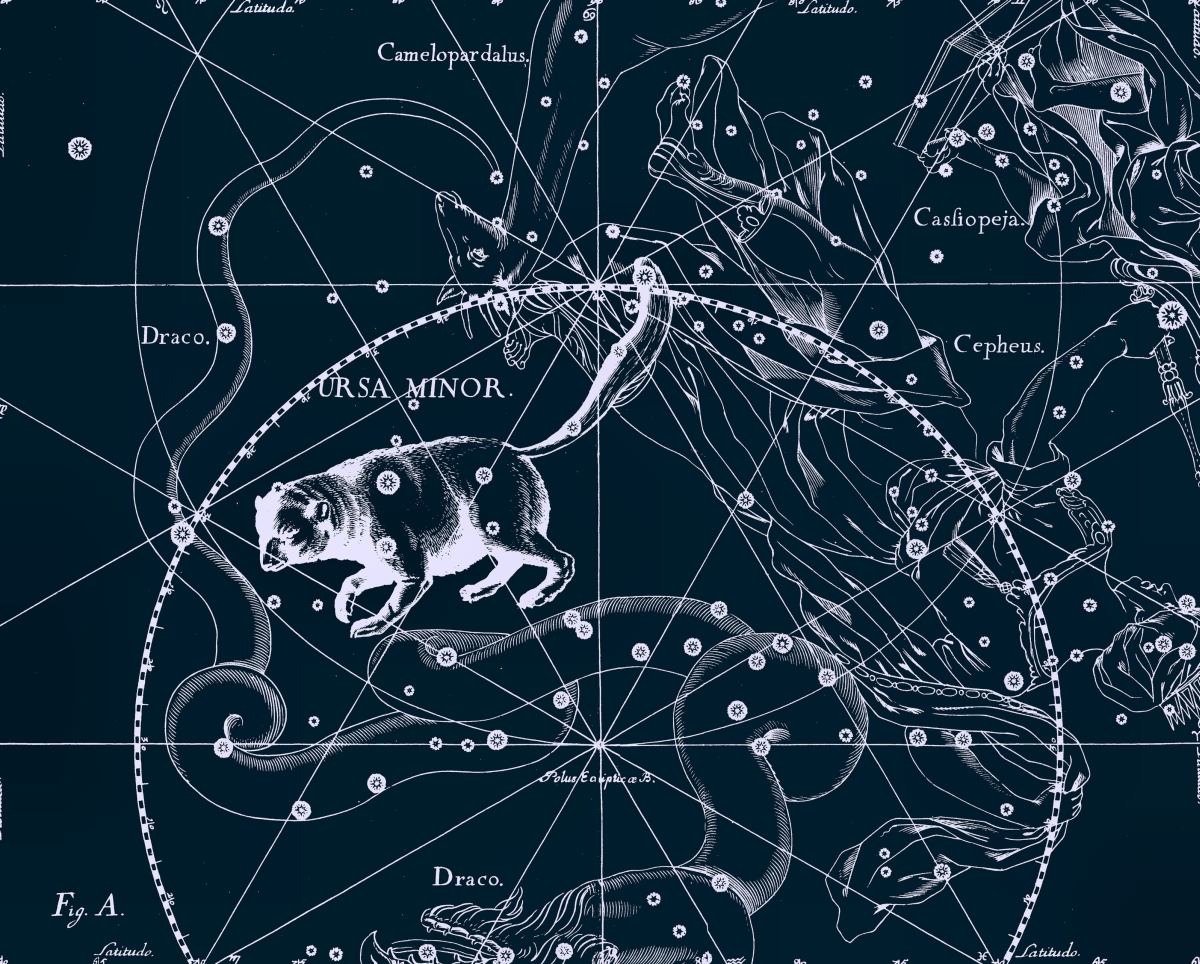
Ursa Minor is a small constellation of the Northern Hemisphere, comprising 25 visible stars. The seven largest of them form in the sky a bucket pattern, the handle of which is completed by the North Star. Ursa Minor does not go beyond the horizon, so a small dipper, using some landmarks, can be seen at night even with the naked eye.
How to find the Little Dipper - choose the right situation
In order for the observation of the stars to be successful, remember our tips:
- look for stars on a clear night so that there are no clouds and stratus in the sky;
- go out of the city, where there are no burning street lamps and luminous windows of houses, but there is a huge dark sky, where you can easily find the Little Dipper;
- When starting the observation, stand in such a way that tall trees or buildings do not block your horizon. The best option is when there are no obstacles at all, that is, the horizon is clear.
How to find the Little Dipper by the Polar Star
This famous star is not the brightest in the sky, so it’s better to look for it along the Big Dipper, which looks like a giant dipper. The constellation is seen in the sky at night in good weather - in autumn and winter it hangs in the northern part of the sky, in the spring it stands in the east upright - pen down, in summer - in the west, pen up.
- Applying our recommendations, find the Big Dipper in the sky. Mentally connect the line with all the stars - get a bucket with a handle.
- Pay attention to the bowl, consisting of 4 stars. The outermost of them pointing stars - Dubhe and Merak, they determine the location of the North Star.
- Connect Merak and Dubha with an imaginary ray. Extend it up and slightly to the right, at a distance greater than five times than the segment between these stars. At the end of the line you will see the Polaris - the end point of the handle of the small bucket.
If even after such investigations you cannot fully present the Little Dipper, use the following hint.
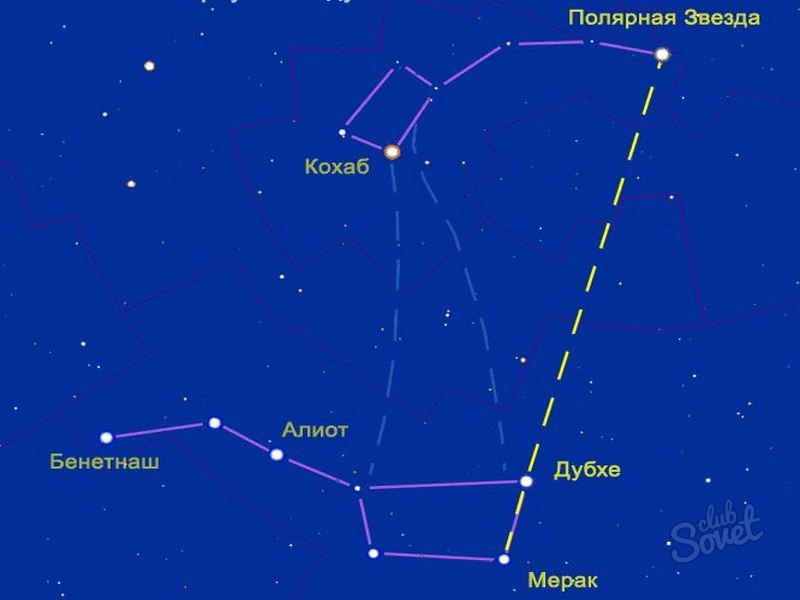
How to find the Little Dipper - an additional landmark
Have you found the Polar Star, but the small dipper does not appear? In this case, the giant stars of the front side of the bowl of Ursa Minor - Kokhab and Farkad will help.
- Look at left side from the Polar Star and notice a bright circle in an orange halo - this is Kokhab, above it, forming the top corner of the scoop - Ferkad. These stars go around the North Star and are called the Guardians of the Pole.
- Take a closer look, and you will see 2 more stars that make up the inner corners of the bowl. Combine them with lines and in front of you - a bucket without a handle.
- Seek out two dimly star-points between the bowl and the North Star. Tie the remaining gaps in straight lines and a small bucket with a handle facing the opposite side from the handle of the Big Dipper.
Although the Little Dipper can be found at any time, it is best seen in the sky in the winter before sunrise or in the first hour of spring sunset.
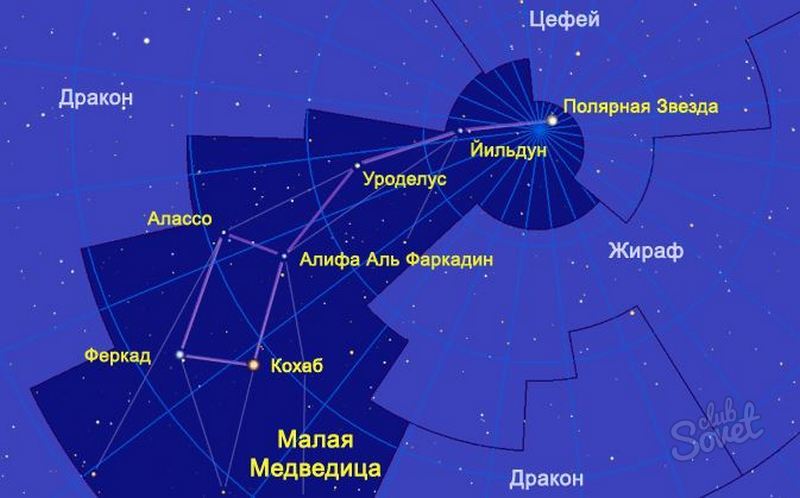
If time permits, go to nature to take a break from the bustle of the city, admire the star-scattering of the night sky, think about distant unknown worlds, the light from which does not reach our planet.
Did you find it in the sky?Still something like a "coffee pot", is not it?
1. In which area of the sky was the constellation of Cassiopeia during your observations?
2. In what area of the sky was the “dipper” of Ursa Major?
3. Could you see Alcor with the naked eye?
